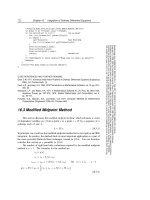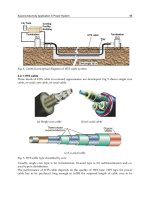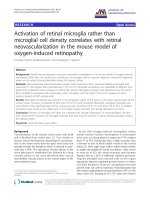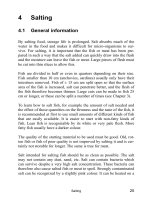ISO 260214:2009 Road vehicles Endoflife activation of onboard pyrotechnic devices Part 4: Additional communication line with bidirectional communication
Bạn đang xem bản rút gọn của tài liệu. Xem và tải ngay bản đầy đủ của tài liệu tại đây (940.21 KB, 18 trang )
INTERNATIONAL ISO
STANDARD 26021-4
First edition
2009-05-15
Road vehicles — End-of-life activation of
on-board pyrotechnic devices —
Part 4:
Additional communication line with
bidirectional communication
Véhicules routiers — Activation de fin de vie des dispositifs
pyrotechniques embarqués —
Partie 4: Ligne de communication additionnelle avec communication
bidirectionnelle
Reference number
ISO 26021-4:2009(E)
© ISO 2009
ISO 26021-4:2009(E)
PDF disclaimer
This PDF file may contain embedded typefaces. In accordance with Adobe's licensing policy, this file may be printed or viewed but
shall not be edited unless the typefaces which are embedded are licensed to and installed on the computer performing the editing. In
downloading this file, parties accept therein the responsibility of not infringing Adobe's licensing policy. The ISO Central Secretariat
accepts no liability in this area.
Adobe is a trademark of Adobe Systems Incorporated.
Details of the software products used to create this PDF file can be found in the General Info relative to the file; the PDF-creation
parameters were optimized for printing. Every care has been taken to ensure that the file is suitable for use by ISO member bodies. In
the unlikely event that a problem relating to it is found, please inform the Central Secretariat at the address given below.
COPYRIGHT PROTECTED DOCUMENT
© ISO 2009
All rights reserved. Unless otherwise specified, no part of this publication may be reproduced or utilized in any form or by any means,
electronic or mechanical, including photocopying and microfilm, without permission in writing from either ISO at the address below or
ISO's member body in the country of the requester.
ISO copyright office
Case postale 56 • CH-1211 Geneva 20
Tel. + 41 22 749 01 11
Fax + 41 22 749 09 47
Web www.iso.org
Published in Switzerland
ii © ISO 2009 – All rights reserved
ISO 26021-4:2009(E)
Contents Page
Foreword............................................................................................................................................................ iv
Introduction ........................................................................................................................................................ v
1 Scope ..................................................................................................................................................... 1
2 Normative references ........................................................................................................................... 1
3 Terms and definitions, abbreviated terms ......................................................................................... 1
3.1 Terms and definitions........................................................................................................................... 1
3.2 Abbreviated terms ................................................................................................................................ 2
4 Conventions .......................................................................................................................................... 2
5 Pyrotechnic device deployment via on-board diagnostic architecture .......................................... 2
5.1 Vehicle system description ................................................................................................................. 2
5.2 Example of in-vehicle hardware and software provision ................................................................. 3
5.3 Additional communication line ........................................................................................................... 3
6 ACL with bidirectional specification (Hardware description) .......................................................... 4
6.1 Connection to the vehicle .................................................................................................................... 4
6.2 Physical layer ........................................................................................................................................ 4
7 Deployment process with ACL and bidirectional communication .................................................. 5
7.1 Deployment process – overview ......................................................................................................... 5
7.2 Data link layer........................................................................................................................................ 5
7.3 ACL step 1 – request deployment sequence ..................................................................................... 7
7.4 ACL step 2 – deployment confirmation sequence ............................................................................ 9
7.5 ACL step 3 – deployment terminfation sequence ............................................................................. 9
7.6 Summary of data byte format transmitted during ACL steps 1, 2 and 3....................................... 10
Bibliography ..................................................................................................................................................... 11
© ISO 2009 – All rights reserved iii
ISO 26021-4:2009(E)
Foreword
ISO (the International Organization for Standardization) is a worldwide federation of national standards bodies
(ISO member bodies). The work of preparing International Standards is normally carried out through ISO
technical committees. Each member body interested in a subject for which a technical committee has been
established has the right to be represented on that committee. International organizations, governmental and
non-governmental, in liaison with ISO, also take part in the work. ISO collaborates closely with the
International Electrotechnical Commission (IEC) on all matters of electrotechnical standardization.
International Standards are drafted in accordance with the rules given in the ISO/IEC Directives, Part 2.
The main task of technical committees is to prepare International Standards. Draft International Standards
adopted by the technical committees are circulated to the member bodies for voting. Publication as an
International Standard requires approval by at least 75 % of the member bodies casting a vote.
Attention is drawn to the possibility that some of the elements of this document may be the subject of patent
rights. ISO shall not be held responsible for identifying any or all such patent rights.
ISO 26021-4 was prepared by Technical Committee ISO/TC 22, Road vehicles, Subcommittee SC 3,
Electrical and electronic equipment.
ISO 26021 consists of the following parts, under the general title Road vehicles — End-of-life activation of
on-board pyrotechnic devices:
⎯ Part 1: General information and use case definitions
⎯ Part 2: Communication requirements
⎯ Part 3: Tool requirements
⎯ Part 4: Additional communication line with bidirectional communication
⎯ Part 5: Additional communication line with pulse width modulated signal
iv © ISO 2009 – All rights reserved
ISO 26021-4:2009(E)
Introduction
Worldwide, nearly all new vehicles are equipped with one or more safety systems. This can include advanced
protection systems based on pyrotechnic actuators. All components which contain pyrotechnic substances
can be handled in the same way.
Recycling these vehicles demands a new process to ensure that the deactivation of airbags is safe and
cost-efficient. Due to the harmonization of the on-board diagnostic (OBD) interface, there is a possibility of
using it for on-board deployment, which is based on the same tools and processes.
Representatives of the global automobile industry agreed that automobile manufacturers
⎯ do not support reuse as an appropriate treatment method for pyrotechnic devices,
⎯ believe treatment of pyrotechnic devices is required before shredding, and
⎯ support in-vehicle deployment as the preferred method.
Based on this agreement, the four big associations of automobile manufacturers (ACEA, Alliance, JAMA and
KAMA) started to develop a method for the “in-vehicle deployment of pyrotechnic components in cars with the
pyrotechnic device deployment tool (PDT)”. The objective is that in the future a dismantler will use only one
tool without any accessories to deploy all pyrotechnic devices inside an end-of-life vehicle (ELV) by using an
existing interface to the car.
Because of different requirements and safety concepts an additional communication line (ACL) is added to the
basic CAN communication method. In this part of ISO 26021 ACL is used to mean an additional
communication line with bidirectional communication. This bidirectional communication is used for systems
with a specific concept that the initiation requires ECU acknowledgement.
© ISO 2009 – All rights reserved v
INTERNATIONAL STANDARD ISO 26021-4:2009(E)
Road vehicles — End-of-life activation of on-board pyrotechnic
devices —
Part 4:
Additional communication line with bidirectional
communication
1 Scope
This part of ISO 26021 defines the requirements of redundancy hardware or software systems independent
from the controller area network (CAN) line, which are activated by the additional communication line (ACL
hardware line).
It also describes the additional sequences of the deployment process, and the technical details for the direct
hardware connection between the pyrotechnic device deployment tool (PDT) and the pyrotechnic control unit
(PCU).
2 Normative references
The following referenced documents are indispensable for the application of this document. For dated
references, only the edition cited applies. For undated references, the latest edition of the referenced
document (including any amendments) applies.
ISO 14230-1, Road vehicles — Diagnostic Systems — Keyword Protocol 2000 — Part 1: Physical layer
ISO 15031-3, Road vehicles — Communication between vehicle and external equipment for emissions-related
diagnostics — Part 3: Diagnostic connector and related electrical circuits, specification and use
ISO 15765-3, Road vehicles — Diagnostics on Controller Area Networks (CAN) — Part 3: Implementation of
unified diagnostic services (UDS on CAN)
ISO 15765-4, Road vehicles — Diagnostics on Controller Area Networks (CAN) — Part 4: Requirements for
emissions-related systems
ISO 26021-1, Road Vehicles — End-of-life activation of on-board pyrotechnic devices — Part 1: General
information and use case definitions
ISO 26021-2, Road Vehicles — End-of-life activation of on-board pyrotechnic devices — Part 2:
Communication requirements
ISO 26021-3, Road Vehicles — End-of-life activation of on-board pyrotechnic devices — Part 3: Tool
requirements
3 Terms and definitions, abbreviated terms
3.1 Terms and definitions
For the purposes of this document, the terms and definitions given in ISO 14230-1, ISO 15031-3, ISO 15765-3,
ISO 15765-4, ISO 26021-1, ISO 26021-2 and ISO 26021-3 apply.
© ISO 2009 – All rights reserved 1
ISO 26021-4:2009(E)
3.2 Abbreviated terms
ACL additional communication line
PDT pyrotechnic device deployment tool
PCU pyrotechnic control unit
OBD on-board diagnostic
OSI open systems interconnection
4 Conventions
This International Standard is based on the conventions discussed in the OSI service conventions
(ISO/IEC 10731) as they apply for diagnostic services.
5 Pyrotechnic device deployment via on-board diagnostic architecture
5.1 Vehicle system description
This International Standard is based on an envisaged diagnostic network architecture in combination with the
PCU deployment architecture, as described in this subclause.
ISO 26021-2 defines the mandatory vehicle interface of the PCU and PDT. The PCU is connected with the
vehicle diagnostic connector and the communication specifications comply with ISO 15765-3 and
ISO 15765-4. The PDT communicates with the PCU on CAN_H and CAN_L and enables deployment with
bidirectional communication.
Depending upon the vehicle-specific architecture, the mandatory link of the PCU may be connected via a
gateway to the OBD connector (see Figure 1), thus a CAN interface in the PCU for the mandatory link may not
be required.
Figure 1 — Access to the vehicle via diagnostic connector
2 © ISO 2009 – All rights reserved
ISO 26021-4:2009(E)
5.2 Example of in-vehicle hardware and software provision
To execute the on-board deployment via the OBD link, the PCU software shall have full access to the output
driver stage, which controls the deployment loops. To achieve this, the saving path is controlled via the ACL
with a bidirectional signal (see Figure 2).
Figure 2 — Overview of hardware and software provision
5.3 Additional communication line
Depending on the hardware architecture of the PCU an additional signal is used. General requirements for the
interface between deployment sequence and ACL sequence are given in Clauses 6 and 7.
Figure 3 — Integration of ACL communication into deployment process
© ISO 2009 – All rights reserved 3
ISO 26021-4:2009(E)
The standardized steps specify the diagnostic sequence. The ACL communication step m is the specified
place to enable the hardware saving possibility.
6 ACL with bidirectional specification (Hardware description)
6.1 Connection to the vehicle
The connection to the vehicle shall be made using the connector specified in ISO 15031-3. Table 1 shows the
contact allocation according to ISO 15031-3 and additional communication line is assigned to contact 15.
Table 1 — Contact allocation of diagnostic connector
Contact General allocation
1 Discretionary
2 Bus positive line of SAE J1850
3 Discretionary
4 Chassis ground
5 Signal ground
6 CAN_H line of ISO 15765-4
7 K line of ISO 9141-2 and ISO 14230-4
8 Discretionary
9 Discretionary
10 Bus negative line of SAE J1850
11 Discretionary
12 Discretionary
13 Discretionary
14 CAN_L line of ISO 15765-4
15 L line of ISO 9141-2 and ISO 14230-4, ACL (optional)
16 Permanent positive voltage
6.2 Physical layer
The physical layer of ACL with bidirectional communication shall be compliant with ISO 14230-1 and the
details are shown in Figure 4. (Values for 24 V systems appear in parentheses.)
If no ACL is supported, the line shall be held as high impedance for safety aspects. Therefore, the PCU
cannot receive the L-line signal for diagnostic purposes, even if the legacy scan tool applicable with
ISO 14230-1 is connected to the PCU and, as a result, there is no influence on any scan tool in the field.
During Sys-Init and documentation process, the battery voltage value is read (see ISO 26021-2:2008, 8.4.2).
The appropriate pull up resistor is chosen according to the battery voltage value.
4 © ISO 2009 – All rights reserved
ISO 26021-4:2009(E)
Figure 4 — Physical layer of ACL with bidirectional communication
7 Deployment process with ACL and bidirectional communication
7.1 Deployment process – overview
After the PDT detects the PCU (connector C) the PDT continues the following steps to perform the
deployment process. The main focuses in this document are the additional steps of ACL preparation and ACL
steps 1 to 3.
See ISO 26021-2 for detailed information on standardized steps.
a) ACL-Init
ACL optional information is obtained by the ACL preparation process. The PDT shall skip ACL step 1 and
proceed to connector (F) directly, if no ACL is selected. (Also ACL steps 2 and 3 shall be skipped.) If the
ACL option is selected, the ACL option information specific to each PCU can be obtained in ACL step 1.
b) Device deployment
Before scrapping each device, ACL step 2 shall be executed for confirmation.
c) Deployment termination of one PCU
ACL step 3 shall be executed and the deployment of all devices controlled by the specific PCU is
terminated. If there is more than one PCU, PDT shall proceed to connector (D) and the same process will
be executed until all PCUs are terminated.
7.2 Data link layer
ACL steps 1 to 3 with bidirectional communication, as shown in Figure 5, is originally prepared for airbag
deployment and the details are shown in Figures 7 to 10. Figure 6 shows the byte format for bidirectional
communication; the communication protocol is asynchronous communication without error check. Although
the communication baud rate is 10 400 Bd, it does not include the header, service identifier and check sum
byte.
© ISO 2009 – All rights reserved 5
ISO 26021-4:2009(E)
Figure 5 — Deployment process PCU sequence
6 © ISO 2009 – All rights reserved
ISO 26021-4:2009(E)
Figure 6 — Byte format of bidirectional communication ACL
7.3 ACL step 1 – request deployment sequence
7.3.1 Switching the pull up resistor in PDT
Key
1 PDT obtains the system battery voltage value information by Data Identifier 0x FA 06. (See ISO 26021-2, Table A.6.)
2 ISO 14230-1 defines two types of pull up resistors for the diagnostic tester according to the system battery voltage,
i.e. 510 Ω for 12 V systems and 1 kΩ for 24 V systems. Therefore, the PDT selects the appropriate internal pull up
resistor according to the system battery voltage value information.
Figure 7 — Switching the pull up resistor
© ISO 2009 – All rights reserved 7
ISO 26021-4:2009(E)
7.3.2 Communication between the PDT and the PCU
Key
1 The PDT sends request for deployment data to the PCU.
2 Case 1. If the PCU replies negative response when the PCU can't proceed to the activation process due to some
reasons, the PDT will send request for deployment data to the PCU automatically. After three negative responses,
the PDT will abort the deployment process and proceed to connector (End) of Figure 5.
3 Case 2. If the PDT receives no reply from the PCU for 15 s, the PDT will abort the deployment process and proceed
to connector (End) of Figure 5.
4 Case 3. If the PDT receives response of deployment from the PCU, the PDT proceeds to connector (E) of Figure 5.
Figure 8 — ACL Step 1 sequence Request Deployment Sequence
8 © ISO 2009 – All rights reserved
ISO 26021-4:2009(E)
7.4 ACL step 2 – deployment confirmation sequence
Figure 9 — ACL step 2 sequence: deployment confirmation sequence
The PDT sends the request for deployment confirmation, asking the PCU to ensure that the technician has a
clear intention to deploy.
The PCU replies by sending a response of deployment confirmation and the PDT proceeds to connector (5),
see Figure 5.
7.5 ACL step 3 – deployment terminfation sequence
Figure 10 –ACL step 3 sequence: deployment termination sequence
After all the PCU's deployments are completed, the PDT sends the request for deployment termination and
the PCU replies by sending a response of deployment termination.
The PDT then proceeds to connector (G), see Figure 5.
© ISO 2009 – All rights reserved 9
ISO 26021-4:2009(E)
7.6 Summary of data byte format transmitted during ACL steps 1, 2 and 3
7.6.1 Transmitted data byte
Transmitted data bytes during ACL steps 1, 2 and 3 are summarized in Table 2.
Table 2 — Transmitted data byte
Deployment Deployment Deployment Negative
confirmation termination response
Request 0x 21 0x 27 0x 30 —
Response 0x 61 0x 67 0x 70 0x 7F
NOTE Although not technically important, deployment confirmation data corresponds to security access
SI value and wait data corresponds to negative response SI value given in ISO 14229-1.
7.6.2 P2, P3 and P4 timing requirements
P2, P3 and P4 timing requirements are shown in Table 3.
Table 3 — P2, P3 and P4 timing requirements
Timing parameter P2 P3 P4
Duration 1 ms to 50 ms 1 ms to 100 ms 1 ms to 1 000 ms
10 © ISO 2009 – All rights reserved
ISO 26021-4:2009(E)
Bibliography
[1] ISO 9141, Road vehicles — Diagnostic systems — Requirements for interchange of digital information
[2] ISO 9141-2, Road vehicles — Diagnostic systems — Part 2: CARB requirements for interchange of
digital information
[3] ISO/IEC 10731, Information technology — Open Systems Interconnection — Basic Reference
Model — Conventions for the definition of OSI services
[4] ISO 14229-1, Road vehicles — Unified diagnostic services (UDS) — Part 1: Specification and
requirements
[5] ISO 14230-4, Road vehicles — Diagnostic systems — Keyword Protocol 2000 — Part 4: Requirements
for emission-related systems
[6] SAE J1850, Class B Data Communications Network Interface
© ISO 2009 – All rights reserved 11
ISO 26021-4:2009(E)
ICS 43.040.80
Price based on 11 pages
© ISO 2009 – All rights reserved









